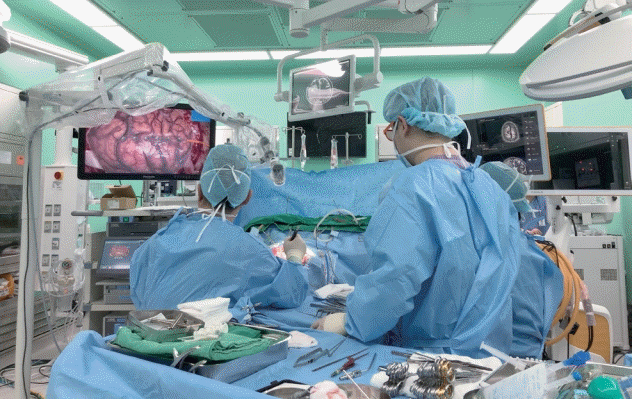Response to questionnaire
Respondents scored the exoscopes relatively low regarding image quality on the monitor. In questions regarding overall image quality, VOMS-100, VITOM 3D, and Kinevo 900 had a mean score of 3.2, 3.9, and 4 points, respectively. A statistically significant difference was observed between VOMS-100 and Kinevo 900 (
p=0.01) but not between VITOM 3D and Kinevo 900 (
p=0.27). When the bleeding site was determined, VOMS-100, VITOM 3D, and Kinevo 900 scored a mean of 3.1, 3.5, and 4 points, respectively. Statistically, VOMS-100 was significantly inferior to Kinevo 900 (
p=0.04), however, the VITOM 3D was not different from Kinevo 900 (
p=0.21). When the image was magnified, VOMS-100, VITOM 3D, and Kinevo 900 scored a mean of 2.9, 3.4, and 4.2 points, respectively. Both exoscopes showed a statistical difference from the Kinevo 900 (
p=0.00 in VOMS-100;
p=0.03 in VITOM 3D). In the question regarding overall brightness, VOMS-100, VITOM 3D, and Kinevo 900 scored a mean of 3.2, 3.8, and 4.3 points, respectively. The brightness of VOMS-100 was significantly lower than that of Kinevo 900 (
p=0.01), but that of the VITOM 3D was not (
p=0.21). In the question of brightness of deep surgical field, VOMS-100, VITOM 3D, and Kinevo 900 scored a mean of 3.1, 3.6, and 4 points, respectively. In addition, statistically significant difference was observed between VOMS100 and Kinevo 900 (
p=0.02) but not between VITOM 3D and Kinevo 900 (
p=0.22) (
Fig. 2A).
 | Fig. 2.Results of questionnaire regarding the experience of using exoscopes (VOMS-100 or VITOM 3D) compared with the OM (Kinevo 900). A : Questions regarding image quality on the display monitor. VITOM 3D was equivalent to Kinevo 900 except for quality of the magnified image (Q. 3). However, VOMS-100 was inferior to Kinevo 900 in all aspects (Q. 1–5). B : Questions regarding handling of equipment. Exoscopes were inferior in focusing on the surgical field (Q. 7). However, exoscopes were superior in accessibility of instruments in the surgical field (Q. 6) and amount of space occupied in the operating theater (Q. 9). C : Questions regarding ergonomics and educational usefulness. Difference was not observed between exoscope and OM. D : Questions regarding 3D glasses and expectations. Discomfort in wearing the 3D glasses was not reported, and respondents had high expectations regarding substitution of exoscopes for the OM. *p<0.05. Q : question, N/C : no choice, OM : operating microscope. 
|
In the question regarding accessibility of instruments in the surgical field, VOMS-100, VITOM 3D, and Kinevo 900 scored a mean of 3.9, 4.2, and 3.6 points, respectively. VITOM 3D showed a statistically significant difference compared with Kinevo 900 (
p=0.04) but not VOMS-100 (
p=0.46). Regarding the ease of focusing on the surgical field, VOMS-100, VITOM 3D, and Kinevo 900 scored a mean of 3.4, 3.6, and 4.4 points, respectively. A statistical difference was observed between the exoscopes and the OM (
p=0.00 in VOMS-100;
p=0.02 in VITOM 3D). In the question regarding convenience of preparation and installation, VOMS-100, VITOM 3D, and Kinevo 900 scored a mean of 3.3, 3.5, and 3.2 points, respectively, and statistical difference was not observed between the exoscopes and the OM (
p=0.84 in VOMS-100;
p=0.49 in VITOM 3D). Regarding the amount of space occupied in the operating theater, VOMS-100, VITOM 3D, and Kinevo 900 scored 3.1, 3.1, and 4.3 points, respectively. Both exoscopes received significantly lower scores compared with the OM (
p=0.00 in VOMS-100;
p=0.00 in VITOM 3D). However, statistical difference was not observed between exoscopes and the OM in overall convenience during surgery; mean 3.8, 3.8, and 3.7 points for VOMS-100, VITOM 3D, and Kinevo 900, respectively (
p=0.89 in VOMS-100 vs. Kinevo 900,
p=0.83 in VITOM 3D vs. Kinevo 900) (
Fig. 2B).
In the question regarding eye fatigue during surgery, the VOMS-100, VITOM 3D, and Kinevo 900 scored a mean of 3.6, 3.6, and 3.8 points, respectively (
p=0.69 in VOMS-100 vs. Kinevo 900,
p=0.78 in VITOM 3D vs. Kinevo 900). In the question regarding body discomfort during surgery, VOMS-100, VITOM 3D, and Kinevo 900 scored a mean of 2.8, 3.1, and 3.4 points, respectively, with no statistical difference (
p=0.22 in VOMS-100 vs. Kinevo 900,
p=0.53 in VITOM 3D vs. Kinevo 900). In the question regarding use for educational purpose, VOMS-100, VITOM 3D, and Kinevo 900 received a mean of 3.8, 4, and 3.8 points, respectively, with no statistical difference between exoscopes and the OM (
p=0.81 in VOMS-100 vs. Kinevo 900,
p=0.43 in VITOM 3D vs. Kinevo 900) (
Fig. 2C).
Regarding the preference between eyepiece lens and 3D glasses, eight respondents chose 3D glasses, five selected eyepiece lenses, and five did not have a preference. Statistical difference was not observed among respondents regarding experience of dizziness when wearing 3D glasses (
p=0.84). In the question whether exoscopes can be a substitute for OM during brain tumor surgery, nine respondents answered it was currently possible, and 10 respondents answered it will be possible in the future (
Fig. 2D).






 PDF
PDF Citation
Citation Print
Print



 XML Download
XML Download